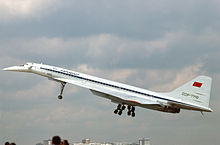1978 Yegoryevsk Tu-144 crash
 A Tupolev Tu-144 similar to the accident aircraft | |
| Accident | |
|---|---|
| Date | 23 May 1978 |
| Summary | Fuel leak and in-flight fire leading to crash landing in a field |
| Site | near Yegoryevsk, Moscow Oblast, Russian SFSR, Soviet Union (now in Russia) 55°23′41″N 38°51′38″E / 55.39472°N 38.86056°ECoordinates: 55°23′41″N 38°51′38″E / 55.39472°N 38.86056°E |
| Aircraft | |
| Aircraft type | Tupolev Tu-144D |
| Operator | Aeroflot |
| Registration | СССР-77111 |
| Flight origin | Ramenskoye Airport |
| Destination | Ramenskoye Airport |
| Occupants | 8 |
| Passengers | 0 |
| Crew | 8 |
| Fatalities | 2 |
| Survivors | 6 |
The 1978 Yegoryevsk Tu-144 crash occurred during a test flight of a Tupolev Tu-144 on 23 May 1978. The aircraft suffered a fuel leak, which led to an in-flight fire in the right wing, forcing the shutdown of two of the aircraft's four engines. One of the two remaining engines subsequently failed, forcing the crew to make a belly landing in a field near Yegoryevsk, Moscow Oblast. Two flight engineers were killed in the ensuing crash, but the remaining six crew members survived. The accident prompted a ban on passenger flights of the Tu-144, which had already been beset by numerous problems, leading to a lack of interest that ultimately resulted in the Tu-144 program's cancellation.
Aircraft and crew[]
The aircraft was a supersonic Tupolev Tu-144D, registered СССР-77111, built at the Voronezh Aircraft Production Association facility and destined for Soviet flag carrier Aeroflot. It had first flown on 27 April 1978 and completed test flights on 12 May, 16 May, and 18 May, as well as another test flight earlier on the day of the accident. The accident flight was to have been the aircraft's sixth test flight. Eight crewmembers were on board.[1]
Accident[]
The aircraft took off from Ramenskoye Airport near Moscow at 17:30 local time on 23 May 1978. The crew intended to perform a series of tests on the aircraft's generators, engines, cabin airtightness, and controllability at 12,000 metres (39,000 ft). Following the completion of the initial series of tests, the crew descended to 3,000 metres (9,800 ft) to test the aircraft's auxiliary power unit (APU). At 18:44:44 local time, the crew started the APU. Less than a minute later, at 18:49:15, the crew shut off the APU. Nine seconds later, a fire alarm was triggered; the number 3 engine was shut down at 18:49:31. The crew decided to attempt a return to Ramenskoye Airport. At 18:51:14, the number 4 engine shut down. The crew subsequently noticed a burning smell and thick smoke in the cabin. The number one engine then shut down at 18:53:27; with three of the aircraft's four engines shut down, it was impossible to return to the airport. At 18:55:18, the aircraft belly landed in a field in Yegoryevsky District, roughly 46 kilometres (29 mi; 25 nmi) from Ramenskoye Airport. The aircraft touched down with the landing gear retracted, at a speed of approximately 380 kilometres per hour (240 mph; 210 kn). The nose cone collapsed on impact, penetrating a compartment in which two flight engineers were seated and killing them both, while the remaining six crewmembers survived the crash.[1][2][3] The aircraft continued to burn for about an hour after the crash before the fire was extinguished by firefighters.[3]
Investigation[]
Investigators found that a fuel leak had occurred in the aircraft's right wing 27 minutes before the fire started. The leaked fuel ignited when the aircraft's auxiliary power unit was turned on. The precise cause of the fuel leak could not be determined, as the components were heavily damaged by fire.[1]
Aftermath[]
The crash resulted in a ban on passenger flights of the Tu-144. Combined with other issues involving the Tu-144, including an earlier crash at the 1973 Paris Air Show and complaints about reliability and passenger comfort, this caused a lack of interest in the Tu-144, which ultimately led to the demise of the Tu-144 program.[4]
See also[]
References[]
- ^ a b c "Crash of a Tupolev TU-144D in Kladkovo: 2 killed". Bureau of Aircraft Accidents Archives. Retrieved 14 Nov 2021.
- ^ "ASN Aircraft accident Tupolev Tu-144D СССР-77111". Aviation Safety Network. Retrieved 14 Nov 2021.
- ^ a b "Катастрофа Ту-144Д Воронежского авиазавода в Егорьевском районе Московской области" [Accident of the Tu-144D of Voronezh Aircraft Plant in Yegoryevsky District of Moscow Oblast] (in Russian). airdisaster.ru. Retrieved 3 Dec 2021.
- ^ Prisco, Jacopo (10 Jul 2019). "Concordski: What ever happened to Soviets' spectacular rival to Concorde?". CNN Style. Retrieved 14 Nov 2021.
- Aviation accidents and incidents in 1978
- Accidents and incidents involving the Tupolev Tu-144
- Aviation accidents and incidents in the Soviet Union
- Airliner accidents and incidents caused by in-flight fires
- 1978 in the Soviet Union
